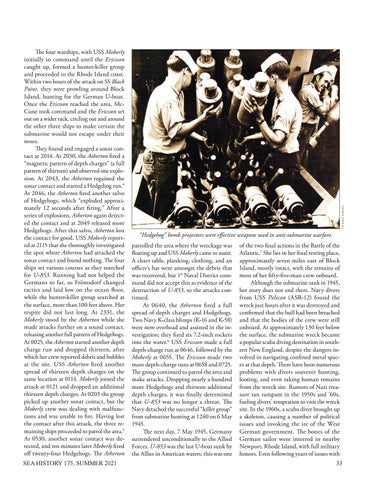us navy photo
The four warships, with USS Moberly initially in command until the Ericsson caught up, formed a hunter-killer group and proceeded to the Rhode Island coast. Within two hours of the attack on SS Black Point, they were prowling around Block Island, hunting for the German U-boat. Once the Ericsson reached the area, McCune took command and the Ericsson set out on a wider tack, circling out and around the other three ships to make certain the submarine would not escape under their noses. They found and engaged a sonar contact at 2014. At 2030, the Atherton fired a “magnetic pattern of depth charges” (a full pattern of thirteen) and observed one explosion. At 2043, the Atherton regained the sonar contact and started a Hedgehog run.4 At 2046, the Atherton fired another salvo of Hedgehogs, which “exploded approximately 12 seconds after firing.” After a series of explosions, Atherton again detected the contact and at 2049 released more Hedgehogs. After this salvo, Atherton lost the contact for good. USS Moberly reported at 2115 that she thoroughly investigated the spot where Atherton had attacked the sonar contact and found nothing. The four ships set various courses as they searched for U-853. Running had not helped the Germans so far, so Frömsdorf changed tactics and laid low on the ocean floor, while the hunter-killer group searched at the surface, more than 100 feet above. Her respite did not last long. At 2331, the Moberly stood by the Atherton while she made attacks further on a sound contact, releasing another full pattern of Hedgehogs. At 0025, the Atherton started another depth charge run and dropped thirteen, after which her crew reported debris and bubbles at the site. USS Atherton fired another spread of thirteen depth charges on the same location at 0114. Moberly joined the attack at 0121 and dropped an additional thirteen depth charges. At 0203 the group picked up another sonar contact, but the Moberly crew was dealing with malfunctions and was unable to fire. Having lost the contact after this attack, the three remaining ships proceeded to patrol the area.5 At 0530, another sonar contact was detected, and ten minutes later Moberly fired off twenty-four Hedgehogs. The Atherton
“Hedgehog” bomb projectors were effective weapons used in anti-submarine warfare. patrolled the area where the wreckage was floating up and USS Moberly came to assist. A chart table, planking, clothing, and an officer’s hat were amongst the debris that was recovered, but 1st Naval District command did not accept this as evidence of the destruction of U-853, so the attacks continued. At 0640, the Atherton fired a full spread of depth charges and Hedgehogs. Two Navy K-class blimps (K-16 and K-58) were now overhead and assisted in the investigation; they fired six 7.2-inch rockets into the water.6 USS Ericsson made a full depth-charge run at 0646, followed by the Moberly at 0655. The Ericsson made two more depth-charge runs at 0658 and 0725. The group continued to patrol the area and make attacks. Dropping nearly a hundred more Hedgehogs and thirteen additional depth charges, it was finally determined that U-853 was no longer a threat. The Navy detached the successful “killer group” from submarine hunting at 1240 on 6 May 1945. The next day, 7 May 1945, Germany surrendered unconditionally to the Allied Forces. U-853 was the last U-boat sunk by the Allies in American waters; this was one
of the two final actions in the Battle of the Atlantic.7 She lies in her final resting place, approximately seven miles east of Block Island, mostly intact, with the remains of most of her fifty-five-man crew onboard. Although the submarine sank in 1945, her story does not end there. Navy divers from USS Pelican (ASR-12) found the wreck just hours after it was destroyed and confirmed that the hull had been breached and that the bodies of the crew were still onboard. At approximately 130 feet below the surface, the submarine wreck became a popular scuba diving destination in southern New England, despite the dangers involved in navigating confined metal spaces at that depth. There have been numerous problems with divers souvenir hunting, looting, and even taking human remains from the wreck site. Rumors of Nazi treasure ran rampant in the 1950s and ’60s, fueling divers’ temptation to visit the wreck site. In the 1960s, a scuba diver brought up a skeleton, causing a number of political issues and invoking the ire of the West German government. The bones of the German sailor were interred in nearby Newport, Rhode Island, with full military honors. Even following years of issues with
SEA HISTORY 175, SUMMER 2021 33
